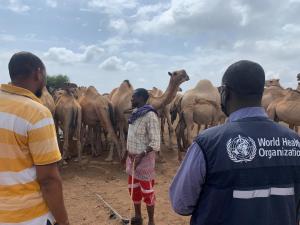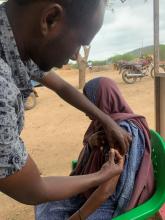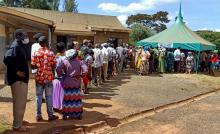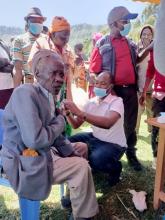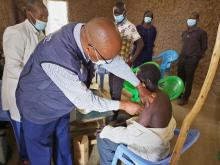Valuable Community Response Lessons for 2022
As 2022 begins, health experts in Kenya have enough to reflect and act on towards vaccine acceleration efforts and sustenance of COVID-19 preventive and safety measures.
MOH in an effort to accelerate vaccination, embarked on a 10-million vaccination race by end of 2021 , even as it targets more millions (27 Million) of vaccination by June 2022. As of December 31, this has effort has been achieved with a record 10,002,184 vaccines administered. Over 4.1 million are fully vaccinated while 5,820,951 are partially vaccinated. These are all above 18 years.
Starting off with daily sharing of trends and figures, active guidance and encouragement-to-act by the MOH Cabinet Secretary Mr Mutahi Kagwe and other high level staff, the call to own and act has been consistently focused and pro-active. MOH first focused on targeted groups – essential workers - health workers, teachers, security forces, then moved on to include older folk of 50 and above, those with comorbidities and now includes over 18 and recently over15 years of age.
In recent months, MOH embarked on the stringent plan to reach more people for vaccination through the 10-million vaccinations target by end of year. They engaged various efforts including partner collaboration, county engagement, risk communication, demand generation, and media engagement and public awareness efforts through social media and social mobilization. This was well complimented by various donations from partners including the US government, European Union, UK, Canada, Argentina, Germany among others whose cumulative contribution has reached 23,279,820 doses.
With the newer threat by Omicron and rising numbers of infections – 3,286 new confirmed COVID-19 cases as of December 30 - the need to sustain vaccination and preventive and protective measures by all, has become as urgent as ever. Kenya’s total number of confirmed cases is at 292,237 as of 30 December. In total 5, 376 deaths have been recorded.
The greatest lesson is that Covid-19 is still here and like the rest of the world, the best lessons learnt and reflection of them, will support every effort to keep the fight on and contain the ever-changing patterns of this pandemic. Currently, government has given new guidelines for people to show evidence of vaccination as a protection against infection of others.
In its support and response, WHO Kenya and various partners have sustained the fight – working hand in hand with MOH through various designated pillars, strategies and actions. In December, WHO Kenya joined the vaccination acceleration campaign in the field and through funding and technical support, collaborated with health colleagues in 11 counties to enhance the vaccine acceleration and preventive effort.
The counties selected out of the 47, cut across various regions and included urban areas, rural, hard to reach and highly populated. The dominant feature was the response challenge manifested by low numbers of vaccination, some as low as 2 percent of the targeted vaccinated population.
The approach – meetings and conversations with stakeholders who in turn reach communities through barazas/local meetings, social mobilization using public address system (town criers) and reaching out to communities at strategic positions (outreach sites). The response – enthusiasm and curiosity - a clear evidence that more people than appreciated, were ready for vaccination and needed more convenience to get it done but also clarity and reliability of information from those they can trust because of the endless misinformation they have to deal with.
In mosques, churches, community social halls, schools, transport terminus, street corners, football fields and the local dispensary, tens and hundreds of people turned up to be vaccinated. In far-flung counties like Samburu, Wajir, Lamu and others where distance from a health facility or other essential services was a great barrier, enabled health teams were pleasantly surprised by the readiness for vaccination.
Colleagues who did a full day journey to reach them, were glad to have made the effort. Most were ready for the vaccine and in Wajir where women were uncertain due to misinformation surrounding infertility questions after the vaccine, soon made up their minds after clarification.
Ekiru from Logeti Baragoi, Samburu county was glad to have gotten the vaccine the second day after missing it the previous day. “It is a personal decision to vaccinate, but the availability is very important to most people here who live far away from services”, she said.
Others were drawn by the convenience and access to the vaccination. “I came to pray and heard that a team was outside the mosque and that I could be vaccinated,” Salim, a 42-year father of two who lives in Kisauni, Mombasa, said. He made up his mind right there to be vaccinated.
Another, Omar, heard the announcement for vaccination at prayer at the Swalihini Mosque, Mombasa and made up his mind to go for it. He said while he had nothing against vaccination, he had not found time to visit the nearest health facility.
“It is hard for people like me without a regular job to go line-up in order to be vaccinated. “You have to put bread on the table first and if you are not out there where the kibarua (temporary job) is being offered, someone else will get it,”.
Misinformation is a big barrier for many others and they confess, it has just become impossible to escape the fake and confusing information, hence difficult to tell what is right or wrong. “Before you know it, several messages are on your phone and neighbours and relatives reinforce those messages so you don’t go to for vaccination”, another said.
Others think, the health information should have been left to religious leaders who are better trusted. “That is why when my pastor stood up to speak and the health worker gave relevant information and answered our questions, I felt convinced and many others did the turn-around”, Stanley Ramtu said.
Technology in use for registration before vaccination is a great asset for data compilation but with surged numbers, more solutions will support the efforts to reach more people through the Chanjo Platform. Some found solutions in facilitation of extra teams to input information in the system in order to avoid backlogs and use of support from neighbours and family to pre-register vaccines before getting to the vaccination site.
In Old Town where a baraza/meeting called by Senior Chief Ahmed Abdul Razaka agreed to take more initiative, members committed to reaching out to those unvaccinated.
“We rejected the initial effort by government lockdown because we felt victimized as a community, one member said.
“But none of us is safe and we have lost some people. We shall each make effort to reach at least 10 people who are not vaccinated and so that we can all be safe,” members told the chief.
Assistant chief Jeremiah Machache of Majaoni, Shanzu, says more people are embracing healthy behavior change and agreeing to vaccinate to protect themselves and others. Increasingly, the example by leaders like him who have vaccinated, wears masks and insists on keeping distance rubs off on the 14,000-members of community.
“Naona wameanza kufunguka kwa hivyo tuendelee kuwaelezea (they are now embracing the message so let us keep at it), “he emphasized.
In the end, what will count is that these lessons are sustained and communities informed, engaged and encouraged to own the response process for prevention and intervention.
“WHO is glad to have supported this national acceleration campaign and appreciate county government response in this effort, Officer-in-Charge Dr Mona Al-Mudhwahi said. She said the difference in numbers and impact attained in the 10-day effort should help more of such effort and encourage more support by partners and use of gainful strategies and lessons from the field. Overall, the WHO Kenya 10-day and follow-up support raised vaccination numbers by an estimate 300,000.
Overall, lessons include:
- Taking the COVID 19 vaccination to where the people are and addressing specific and localized concerns
- Encouragement of county and stakeholder ownership of COVID 19 vaccination
- Addressing low uptake of COVID 19 vaccine by segments of population to include access barriers, vaccine hesitancy and misinformation, supply chain and vaccine logistics challenges
- Planning for distribution for the short shelf life of the COVID 19 vaccines
- Solutions for data network for pre-registration of ‘vaccinees’
- Ensuring enough stock out of vaccines and syringes at the regional depot given surging numbers
- Review of strategy of COVID 19 vaccination for mobile population and low uptake of vaccines by women in pastoral communities due to misinformation on fertility, breastfeeding and other issues
- Continued advocacy at the national and the county level to increase uptake for COVID 19 vaccines and sustained messages for preventive and protective measures
